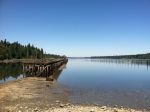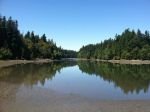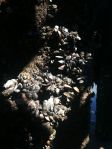A winding journey through young forest delivers you to a dazzling shoreline rich with beauty, history and wildlife.
Distance: 2.5 miles
Time: 1 hour
Steep: No
Challenging: No
Trailhead: 6998 Woodard bay Rd NE Olympia, WA 98606
Woodard Bay lets you know you’re somewhere spectacular as soon as you pull in to the parking lot. It seems like just minutes ago you were driving by houses and cars and people, but now all the eye sees are giant trees, blue water and herons on the mud flats. Peaceful and beautiful, the Woodard Bay trail is one of the best Olympia has to offer.
The trail begins on a paved service road, heading north. Soon, you’ll see a trail on your left that heads into the woods. This trail meanders for over a mile through young Douglas Fir forest with a canopy that sparkles green on sunny days. As with many northwest woodland trails, you can never see very far ahead. There is a calming disorientation in just letting the trail bring you where it will, this way and that, through the abundant displays of sword ferns, salal and salmonberry.
The trail you’re on will emerge once again onto the service road, and you should take a left here. Not far away, the view slowly opens up into an amazing 270 degrees of picturesque Chapman Bay. On center stage, a mighty old railroad trestle stands in the water, unused by man since the 1980s. It has found a new use, though, serving as Washington State’s largest known bat colony. Every night around dusk, during spring and summer, you can see Yuma and Little Brown bats flying out to hunt for insects.
Deeper out into the bay there are floating log booms among barnacle-encrusted pilings, also remnants of Woodard Bay’s industrial past. You may hear strange sounds coming from this direction. Groans, grunts and cries that echo across the water. Looking carefully with binoculars you’ll see that the floating logs are being used by hundreds of Pacific Harbor Seals resting here, sharing lounge space with black cormorants. Occasionally, you’ll also hear a loud squawking to your left, in the woods by the shore. Great Blue Herons build their giant stick nests in these trees and can often be seen flying in and out of the tree cover.
Woodard and Chapman Bays had a pivotal role in the local logging industry for most of the 20th century. The company Weyerhaeuser owned this land from the 1920s through to the 80s, using it as a shipping off point for timber cut in Thurston and Lewis counties. The logs would come in by train and get plopped in the water, to be floated up to the mill, far north in Everett. As transportation and technology advances changed the industry, the Woodard Bay property became unnecessary and was sold to the state of Washington, which protects it as a Natural Resources Conservation Area.
You can take the service road all the way back to your car, a short walk beneath towering Big Leaf Maples festooned with moss. Woodard Bay is as pleasing to the eyes as it is to the ears. A powerful quiet exists here, broken only by the surprising sounds of its animal residents, living amongst the once mighty structures that we left behind.





Jennifer Dickens
I love the forest trail, and the waterfront! It is sooo peaceful, you can hear the sounds of nature and forget about the busy city. I rarely see people out here when my family and I visit, so it’s not a busy crowded place either! The forest trail has boardwalks and amazing trees, and the waterfront is perfect for exploring starfish and creatures under the old railroad trestle. There are picnic benches and a restroom, so you can bring a lunch and spend the day!